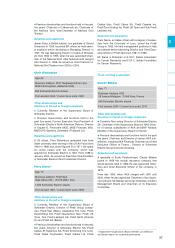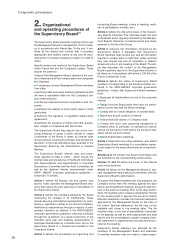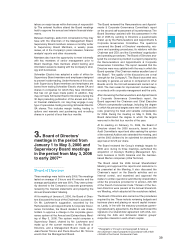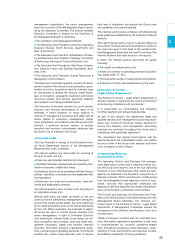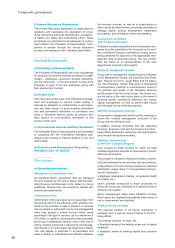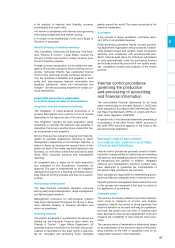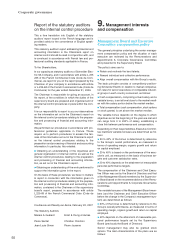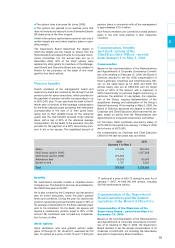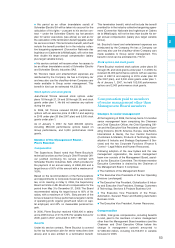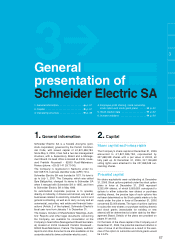APC 2006 Annual Report Download - page 49
Download and view the complete annual report
Please find page 49 of the 2006 APC annual report below. You can navigate through the pages in the report by either clicking on the pages listed below, or by using the keyword search tool below to find specific information within the annual report.
An analysis of financial risks (liquidity, currency,
counterparty and credit risks).
A review of compliance with internal rules governing
intercompany payments and transfer pricing.
A review of the membership of the unit's Board of
Directors or equivalent.
Monthly Treasury Committee meetings
This Committee, chaired by the Executive Vice-Presi-
dent, Finance & Control - Legal Affairs, reviews the
Group's monthly cash position, foreign currency posi-
tion and financing capacity.
Foreign currency transactions for all entities are man-
aged at Group level, except for those involving soft cur-
rencies. Schneider Electric has established internal
control rules governing foreign exchange exposure –
only the operating receivables and payables of each
entity and intercompany financial receivables and
payables (dividends, loans and borrowings) are
hedged – and the accounting treatment of foreign cur-
rency transactions.
b) Specific procedures applicable
to certain types of risks or transactions
Integration of newly-acquired businesses
The integration of newly-acquired businesses is a
process that extends over a period of 6 to 24 months
depending on the type and size of the new entity.
The integration scenario for each acquisition varies
depending on whether the business was acquired to
strengthen the Group’s existing lineup, extend the line-
up or penetrate a new segment.
All told, there are five scenarios ranging from total inte-
gration to separate organization reporting to senior
management. Depending on the strategic objective, a
matrix is drawn up showing the required level of inte-
gration for each of the newly-acquired business’s core
functions, i.e. front office (sales force and brand), back
office, R&D, corporate functions and management
reporting.
An integration plan is drawn up for each acquisition
and submitted to the Acquisitions Committee for
approval. The plan is implemented by an integration
manager who reports to a Steering Committee that ini-
tially meets at monthly intervals and then on a quarter-
ly basis.
New product development
The New Products Committee allocates resources
among new product development, range management
and technological research.
Management processes for technological projects
have been harmonized throughout the Group to allow
more effective tracking of resource allocation and
return on investment.
Industrial property
The patents developed or purchased by the Group are
tracked by the Industrial Property team within the
Finance & Control - Legal Affairs Department. All
industrial property information for the main Group sub-
sidiaries is transmitted to this team, which is responsi-
ble for managing and protecting these intangible
assets around the world. The same procedure is fol-
lowed for trademarks.
Purchases
A key process in Group operations, purchases repre-
sent 40% of consolidated revenue.
Rules governing purchases mainly concern purchas-
ing department organization and procedures, relation-
ships between buyers and vendors, levels of signature
authority, and compliance with environmental stan-
dards. Internal audit plans for individual subsidiaries
or units systematically cover the purchasing function
and include productivity and cost of non-quality analy-
ses, compliance reviews and analyses of the vendor
portfolio.
Internal control procedures
governing the production
and processing of accounting
and financial information
The consolidated financial statements for all fiscal
years commencing on and after January 1, 2005 have
been prepared in accordance with International Finan-
cial Reporting Standards (IFRS), to comply with Euro-
pean Union regulation 1606/2002.
A special note to the financial statements presenting a
reconciliation of the 2004 French GAAP accounts to
the 2004 IFRS accounts appears in the notes to the
annual financial statements.
Internal control procedures
to confirm the existence and value
of assets and liabilities
Internal control procedures generally consist of defin-
ing levels of responsibility for authorizing and checking
transactions, and segregating tasks to help ensure that
all transactions are justified. In addition, integrated
statutory and management reporting systems have
been developed to guarantee the completeness of
transaction data recorded in the accounts.
Each subsidiary is responsible for implementing proce-
dures providing an adequate level of internal control.
Operating Division management teams assist the units
in this process and represent a first level of control in
the application of procedures.
Intangible assets
The process for valuing software and product develop-
ment costs is designed to monitor and analyze
expenses, identify the portion of those expenses that
meet the definition of an asset and may be capitalized,
and track the asset’s use over time. IT systems have
been deployed to track project development costs and
measure the profitability of new products more accu-
rately.
The carrying value of trademarks is determined based
on an assessment of the economic value of the under-
lying business at the time of acquisition and on an
independent valuation of the trademark.
47
2


